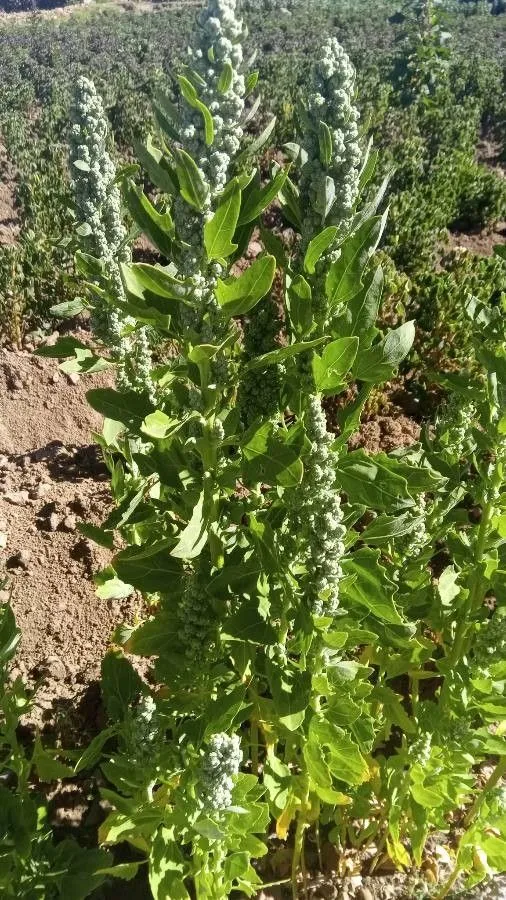
Author: Willd.
Bibliography: Sp. Pl., ed. 4, 1: 1301 (1798)
Year: 1798
Status: accepted
Rank: species
Genus: Chenopodium
Vegetable: False
Observations: Ecuador to NW. Argentina
Quinoa, scientifically known as Chenopodium quinoa, is a highly nutritious and versatile plant that belongs to the Amaranthaceae family. Native to the Andean region of South America, quinoa has been cultivated for thousands of years, spanning areas from Ecuador to northwestern Argentina. This ancient grain is often celebrated for its high protein content and the balance of essential amino acids, making it an excellent dietary staple for both vegetarians and those looking for a gluten-free grain alternative.
The plant itself is quite hardy, capable of thriving in harsh and diverse climates, including altitudes of up to 4,000 meters. Quinoa’s adaptability has earned it the nickname “the lost crop of the Incas,” as it was a critical food source for ancient Andean civilizations. The seeds of the quinoa plant are the main consumable part, though its leaves can also be eaten as a leafy vegetable.
Quinoa seeds are small, bead-like, and come in a variety of colors, including white, red, black, and purple. These seeds are encased in a natural coating called saponin, which must be removed through rinsing before consumption to eliminate its naturally bitter taste. In addition to its culinary uses, quinoa is also praised for its health benefits. It is rich in dietary fiber, vitamins, and minerals such as iron, magnesium, and manganese, and has a low glycemic index, making it a healthy choice for blood sugar management.
Beyond its nutritional benefits, quinoa has also found its way into various traditional and contemporary dishes. It can be used in salads, soups, as a side dish, or even as a breakfast cereal. Its versatility in the kitchen and its numerous health benefits have led to its growing popularity worldwide, especially as people become more aware of the importance of a balanced and nutritious diet.
In scientific literature, quinoa is referenced in Species Plantarum, fourth edition, volume one, on page 1301, published in 1798 by Willdenow. This classic reference highlights the deep historical and botanical roots of quinoa, underscoring its long-standing significance in agriculture and its promising future as a global food source.
Indeed, quinoa’s rich history, resilience, and nutritional profile make it an exceptional plant that continues to grow in relevance as a critical component of global food security and healthy eating practices.
Fra: chénopode
Dan: kvinoa, mel-gåsefod, quinoa
Eng: quinoa
Deu: reis-gänsefuß, reismelde, reismelde, heidenkorn
Ces: merlík
Swe: mjölmålla, rismålla
Est: tšiili hanemalts
Nld: quinoa
Nno: quinoa
Nob: quinoa
En: Quinoa
Ar: كينوا
Hy: Սագախոտ
Ay: Jiwra
Az: Kinoa
Eu: Kinoa
Be: Кіноа
Bg: Киноа
Zh: 藜麥
Hr: Kvinoja
Cs: Merlík čilský, Merlík
Da: Kvinoa, Mel-gåsefod, Quinoa
Nl: Quinoa
Eo: Kvinoo
Et: Tšiili hanemalts
Fi: Kvinoa
Fr: Quinoa, Chénopode
De: Quinoa, Reismelde, Andenhirse, Inkakorn, Inkareis, Perureis, Reisspinat, Reis-Gänsefuß, Reismelde, Heidenkorn
El: Κινόα
He: קינואה
Hi: क्विन्वा
Is: Kínóa
Id: Kinoa
Ga: Cuineo
It: Quinoa
Kn: ಕೀನೋವಾ
Ko: 명아주속의 일년초
Lv: Kinoja
Lt: Bolivinė balanda
Ms: Kuinoa
No: Perumelde, Quinoa
Nb: Quinoa
Nn: Quinoa
Fa: کینوآ
Pl: Komosa ryżowa
Pt-br: Quinoa
Qu: Kinwa
Ru: Киноа
Sr: Kvinoja
Es: Arroz Andino, Kinwa, Kvinoja, Quinua, Quínoa
Sv: Mjölmålla, Rismålla
Ta: கினோவா
Th: คีนวา
Tr: Kinoa
Uk: Кіноа
Ur: کینوآ
Vi: Diêm mạch
© copyright of the Board of Trustees of the Royal Botanic Gardens, Kew.
© copyright of the Board of Trustees of the Royal Botanic Gardens, Kew.
© copyright of the Board of Trustees of the Royal Botanic Gardens, Kew.
Taken May 29, 2020 by Tirmarche (cc-by-sa)
Taken Jul 3, 2018 by LUCAS survey – European Union (©)
Taken Jul 21, 2022 by Anatas (cc-by-sa)
Taken Aug 19, 2016 by Tela Botanica − Yoan MARTIN (cc-by-sa)
Taken Feb 6, 2019 by Jean-Christophe Lombardo (cc-by-sa)
Taken Jan 28, 2017 by Yoan MARTIN (cc-by-sa)
Taken Aug 24, 2020 by Rémi Saudax (cc-by-sa)
Taken Feb 2, 2005 by Tela Botanica − Liliane ROUBAUDI (cc-by-sa)
Taken Feb 6, 2019 by Jean-Christophe Lombardo (cc-by-sa)
Taken Feb 6, 2019 by Jean-Christophe Lombardo (cc-by-sa)
Taken May 18, 2022 by Ignacio Pérez Maíz (cc-by-sa)
Taken Jun 9, 2022 by MikinG (cc-by-sa)
Taken Feb 6, 2019 by Jean-Christophe Lombardo (cc-by-sa)
Taken May 21, 2019 by stonehill angela (cc-by-sa)
Taken Nov 3, 2020 by Comix None (cc-by-sa)
Taken Sep 15, 2005 by Photoflora – Jean-Luc TASSET (©)
Taken Apr 29, 2020 by ilgrandediopan (cc-by-sa)
Taken Jan 28, 2017 by Yoan MARTIN (cc-by-sa)
Taken Sep 10, 2016 by Tela Botanica − Yoan MARTIN (cc-by-sa)
Taken Sep 10, 2016 by Tela Botanica − Yoan MARTIN (cc-by-sa)
Taken Sep 10, 2016 by Tela Botanica − Yoan MARTIN (cc-by-sa)
Taken Aug 19, 2016 by Tela Botanica − Yoan MARTIN (cc-by-sa)
Taken Sep 10, 2016 by Tela Botanica − Yoan MARTIN (cc-by-sa)
Taken Jul 3, 2021 by nat natalia (cc-by-sa)
Taken Jul 15, 2019 by Photoflora – Benoit BOCK (©)
Taken Aug 19, 2016 by Tela Botanica − Yoan MARTIN (cc-by-sa)
Sowing: Direct seed outdoors, thin to 10cm
Row spacing: {‘cm’: 10}
Family: Myrtaceae Author: (F.Muell.) K.D.Hill & L.A.S.Johnson Bibliography: Telopea 6: 402 (1995) Year: 1995 Status:…
Family: Rubiaceae Author: Pierre ex A.Froehner Bibliography: Notizbl. Bot. Gart. Berlin-Dahlem 1: 237 (1897) Year:…
Family: Sapindaceae Author: Koidz. Bibliography: J. Coll. Sci. Imp. Univ. Tokyo 32(1): 38 (1911) Year:…
Family: Asteraceae Author: A.Gray Bibliography: Pacif. Railr. Rep.: 107 (1857) Year: 1857 Status: accepted Rank:…
Family: Fabaceae Author: Medik. Bibliography: Vorles. Churpfälz. Phys.-Ökon. Ges. 2: 398 (1787) Year: 1787 Status:…
Family: Aspleniaceae Author: (Cav.) Alston Bibliography: Bull. Misc. Inform. Kew 1932: 309 (1932) Year: 1932…